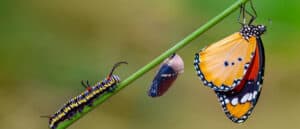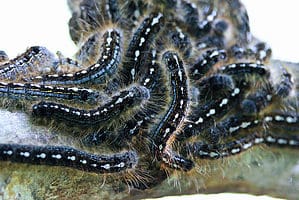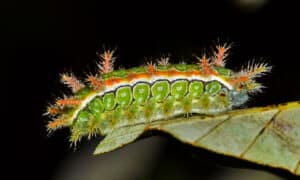There are many, many types of caterpillars in Florida. And today, we’ll introduce you to some of the various caterpillar species in the Sunshine State. Caterpillars, the larval stage of butterflies and moths, come in a range of colors, shapes, and patterns. And what’s more: some of the caterpillars we will be highlighting today are poisonous!
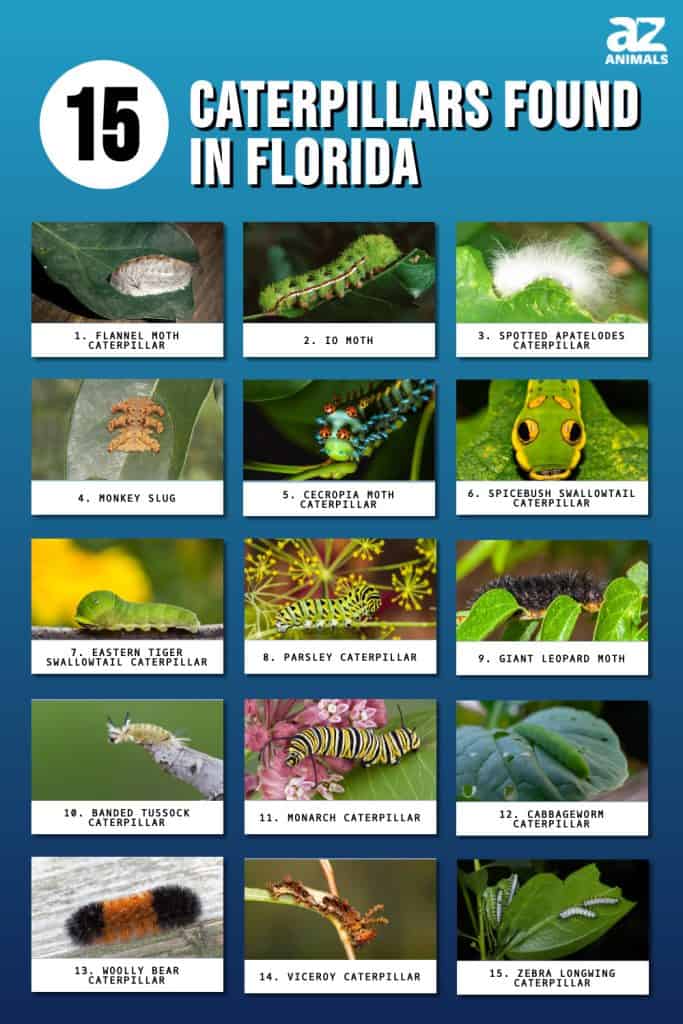
1. Flannel Moth Caterpillar (Megalopyge opercularis)
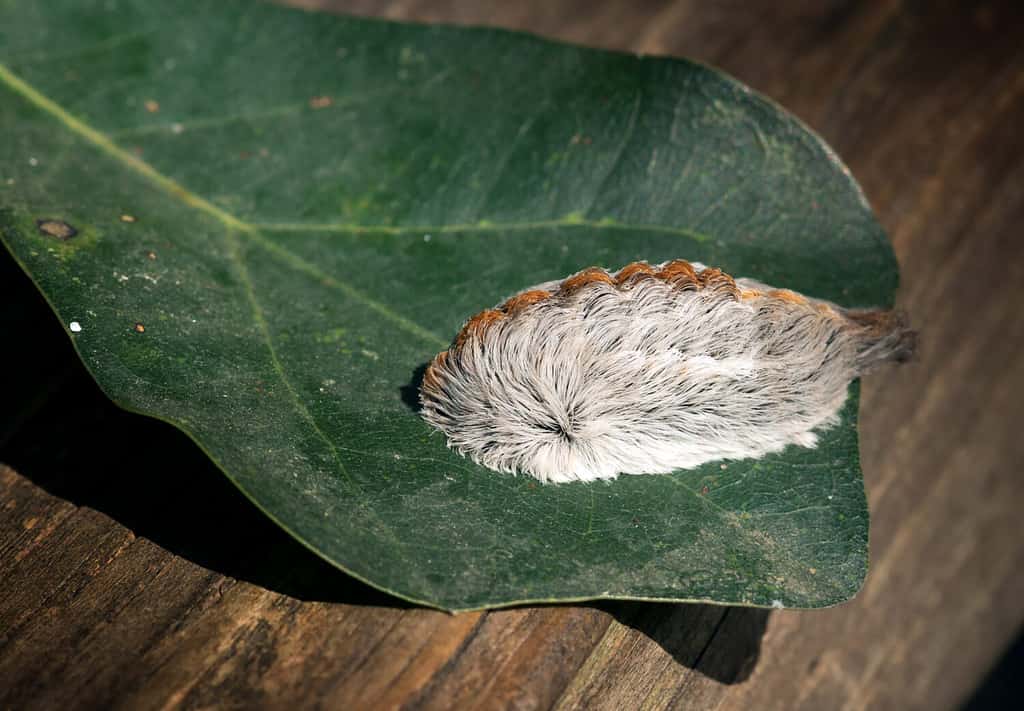
It’s best not to touch fuzzy caterpillars like the flannel moth.
©IrinaK/Shutterstock.com
Beware of fuzzy caterpillars in Florida! They’re likely part of the flannel moth family, known for their dangerously venomous stings. Those who’ve been stung equate the pain to a bone fracture or an intense burning sensation. Yikes!
These critters range in color from creamy white to dark brown. They are covered in long, dense fur that gives them a wig-like appearance. They’re typically about an inch long and half an inch wide. Flannel moth caterpillars favor oak, elm, and wild plum trees as their habitats.
While their furry coats may make them look really cute, be careful! Being stung by one of these caterpillars can lead to nasty symptoms, including nausea, chest discomfort, swelling, headaches, and trouble breathing. Such symptoms, particularly in kids, can be severe and warrant medical help. If you suspect you’ve been stung, get medical assistance immediately!
2. Io Moth (Automeris io)

While Io moth caterpillars are venomous, you won’t typically need to go to the hospital.
©iStock.com/Weber
Io moth caterpillars pack a powerful and painful venomous punch in their sting! Thankfully, a sting usually doesn’t necessitate a trip to the doctor. Most advice suggests using scotch tape to remove any remaining spines, then applying a cold pack to the stung area. Pain relievers and common over-the-counter antihistamines can alleviate the discomfort. Pain and swelling should decline after a few hours.
These caterpillars sport a vibrant green color with a pair of red and white stripes running along each side. They also have bunches of short green spines.
Generally, you’ll find Io moth caterpillars on hackberry and willow trees. They may not be as noticeable compared to some of the other caterpillars on this list, but you should be able to spot their spiny green tufts against the green leaves if you look hard enough!
3. Spotted Apatelodes Caterpillar (Apatelodes torrefacta)
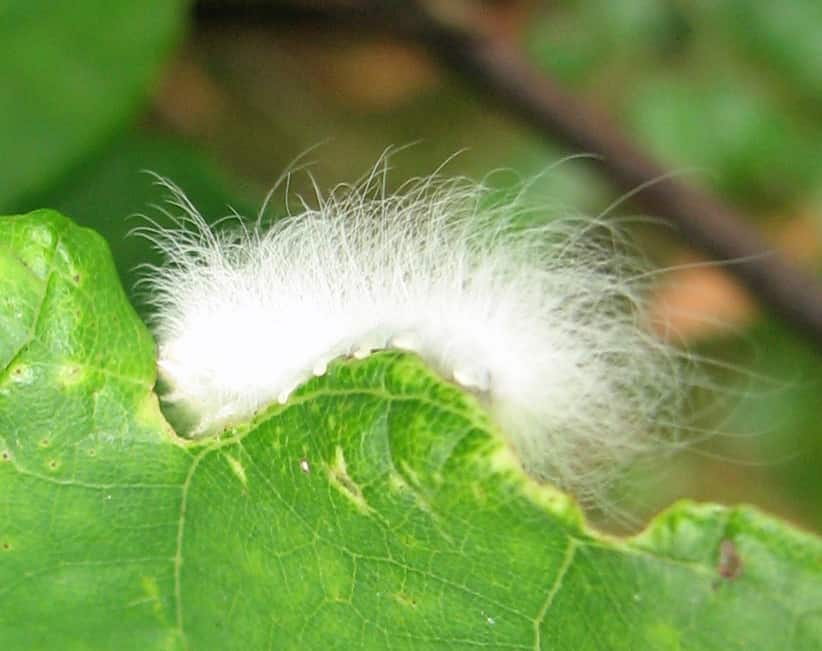
One of the most beautiful caterpillars in Florida is the spotted apatelodes.
©Jacy Lucier / CC BY-SA 4.0 – License
In Florida, if you’re on the hunt for the most beautiful caterpillar, the spotted apatelodes definitely takes the cake! This species boasts a fuzzy coat and tiny patches of black fur, giving it the appearance of an adorable plush toy. Its hue can range from a striking white to a sunny yellow. The spotted apatelodes caterpillar also boasts black, antenna-like bristles from its back.
It prefers to reside in ash, maple, and oak trees.
While the spotted apatelodes caterpillar isn’t poisonous, some individuals might have an allergic reaction to its fur. Generally, this little creature poses no harm and is safe to handle or accidentally brush up against.
You’ll usually find this caterpillar in the latter part of the summer season, frequently making its home in various fruit trees.
4. Monkey Slug (Phobetron pithecium)
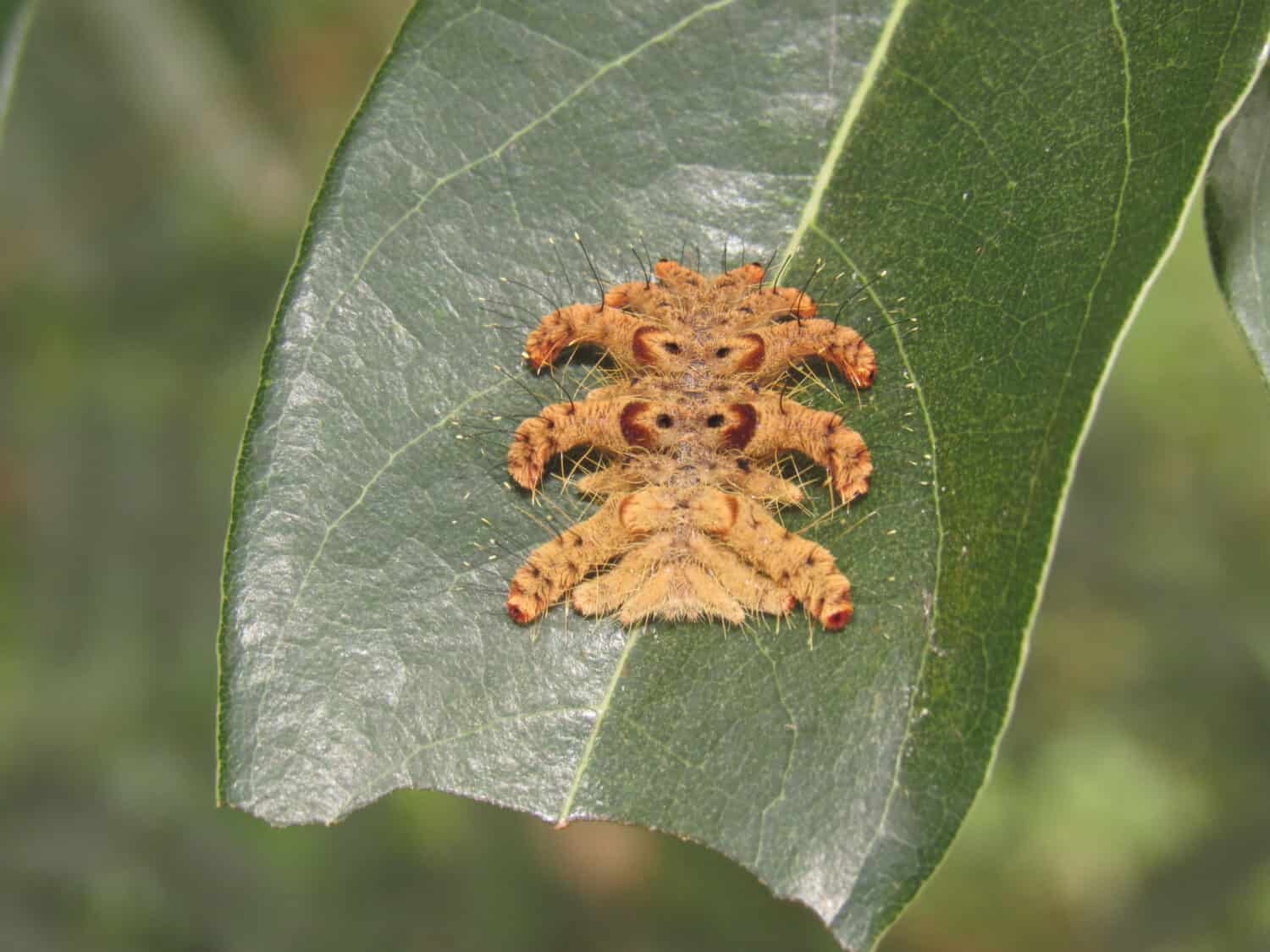
One of the most interesting looking caterpillars is the monkey slug caterpillar.
©Fabio Ara/Shutterstock.com
Spotting a monkey slug caterpillar should be easy! Its unique body shape sets it apart from other caterpillars in Florida. With its many hairy, leg-like projections, it could be easily mistaken for an excessively furry spider rather than a caterpillar! Its hue ranges from a sandy tan to a rich brown, with a lighter belly. Seven pairs of appendages stick out from its broad, flat body.
Monkey slugs aren’t picky about their habitat, making any plant or tree with a woody stem their home.
Despite their fierce looks, monkey slugs are relatively harmless. Their venom typically causes only a minor skin rash. They are solitary creatures, so it’s rare to spot more than one at a time.
5. Cecropia Moth Caterpillar (Hyalophora cecropia)
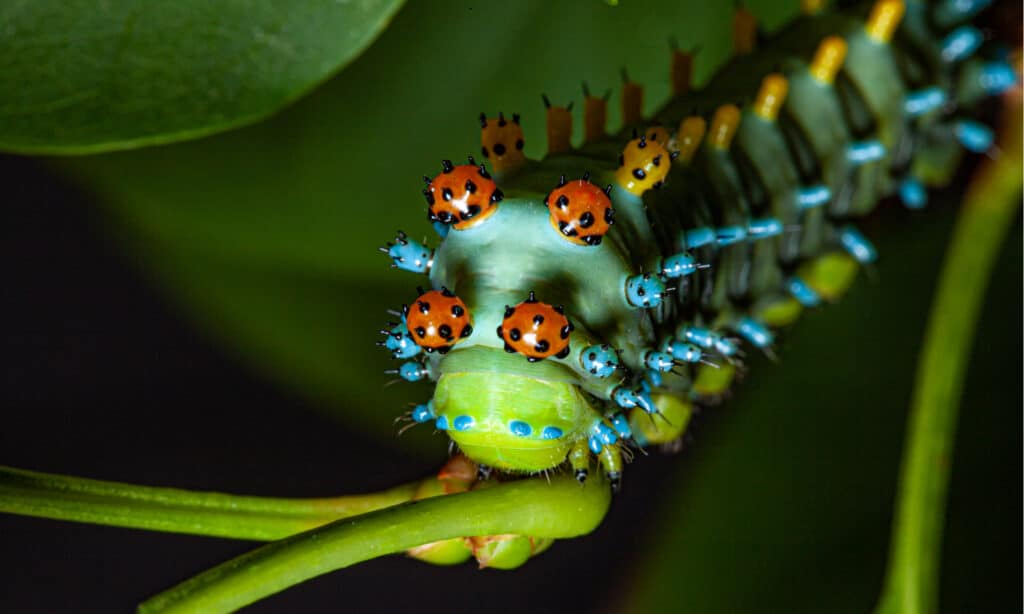
The beautiful colors of the cecropia caterpillars definitely help these little critters stand out!
©K Hanley CHDPhoto/Shutterstock.com
Cecropia caterpillars have an out-of-this-world look! Their hue changes through each stage of growth, but during their late phase, they have a green body with blue, red, and yellow bumps, each capped with black spikes. They have a large, plump body and conspicuous leg extensions.
Their favorite host plants to inhabit are birch, cherry, and maple trees.
In Florida, the cecropia caterpillar is part of a group often referred to as “silkworms.” This moniker comes from the silky cocoon they construct around themselves when they’re about to transform into a moth. The cocoons, which look like wilted leaves, are brown in color and tend to stick to the sides of the plants they inhabit.
If you want to spot one of these caterpillars, your best bet is to hunt around during late spring.
6. Spicebush Swallowtail Caterpillar (Papilio troilus)
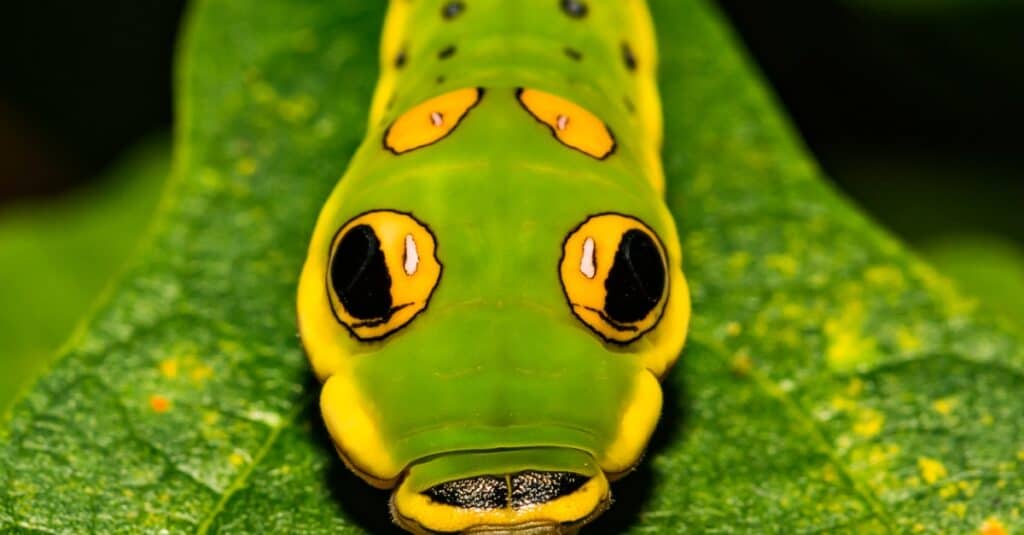
These caterpillars almost have a snake-like look.
©iStock.com/JasonOndreicka
The spicebush swallowtail caterpillar is a green-yellow color, with black eyespots surrounded by white and smaller black specks dotting its back. This species has a head that is notably larger than its tail end, and its favored host plants include the spicebush and white sassafras.
Interestingly, all of these traits combined make the caterpillar resemble a somewhat intimidating green snake, especially from the perspective of birds scouting for their next meal.
As the name might suggest, the spicebush swallowtail caterpillar has a preference for the spicebush as a host plant. If you’re thinking of adding spicebush to your garden, make sure it’s a variety native to your location. And once it establishes itself, you might have the pleasure of spotting this uniquely peculiar caterpillar or even its magnificent butterfly adult form!
7. Eastern Tiger Swallowtail Caterpillar (Papilio glaucus)
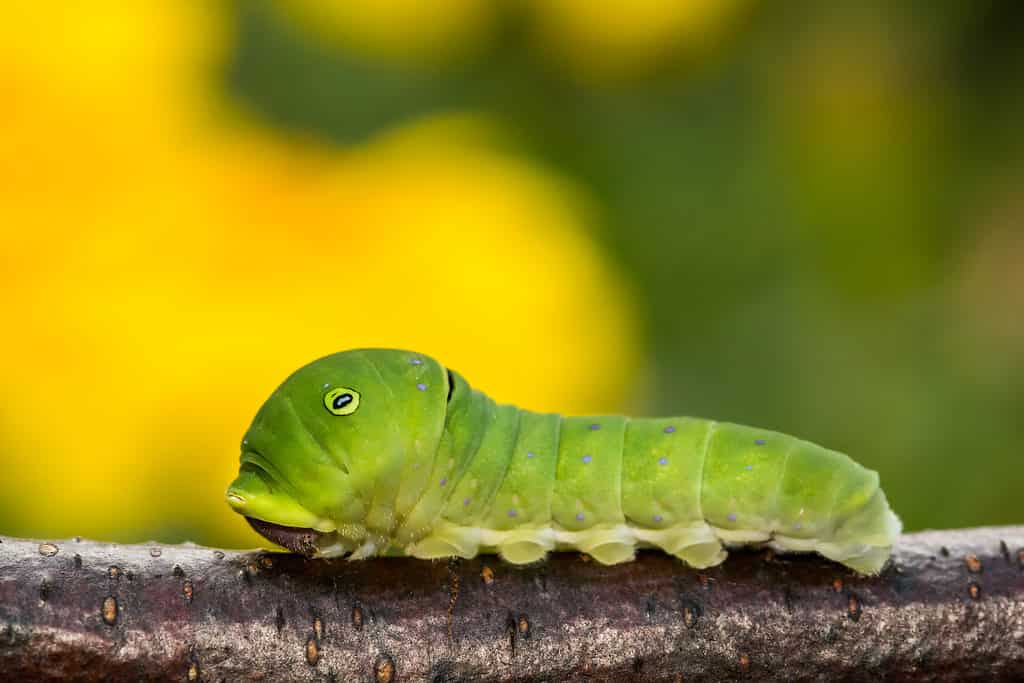
These caterpillars start off green in color then turn to brown and green once again!
©Jay Ondreicka/Shutterstock.com
Eastern tiger swallowtail caterpillars start their life journey in a lovely shade of green. As they grow, they transform into a brown hue and showcase yellow stripes and black dots across their bodies, only to revert back to green once again.
These caterpillars are a common sight in Florida and often share the same host plant with their adult counterparts, which sip on its nectar. The eastern tiger swallowtail caterpillar has a particular fondness for pink or red blossoms from the dogbane family.
The adult form of this caterpillar, the eastern tiger swallowtail butterfly, makes a bold statement with its distinct colors and patterns.
8. Parsley Caterpillar (Papilio polyxenes)
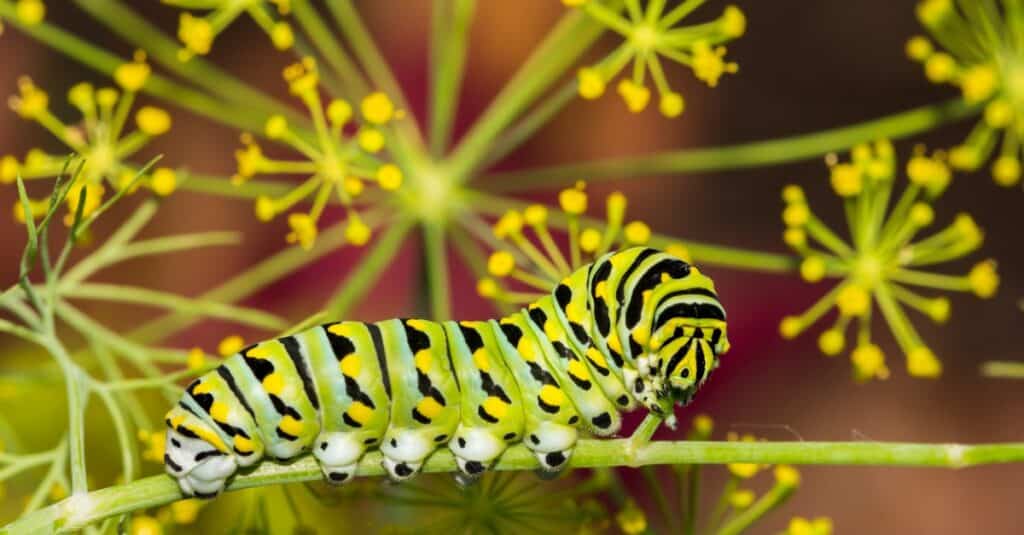
Also called parsley worms, parsley caterpillars love to munch on parsley.
©Jay Ondreicka/Shutterstock.com
Parsley caterpillars, or parsley worms, will eventually transform into the black swallowtail butterfly.
Their body is green in color, adorned with rings of black and yellow spots stretching from head to tail. The caterpillar’s head and upper body section are larger than its back portion, and its legs – including the additional pro-legs – are clearly visible, even from afar.
As you might be able to guess from their name, parsley caterpillars love the parsley plant. So, for those with a green thumb, parsley caterpillars may be a bit bothersome since they can consume an entire parsley plant at an alarming speed. However, if you plant a little extra parsley, the reward will be the opportunity to spot the stunning black swallowtail butterfly after a few weeks!
9. Giant Leopard Moth (Hypercompe scribonia)
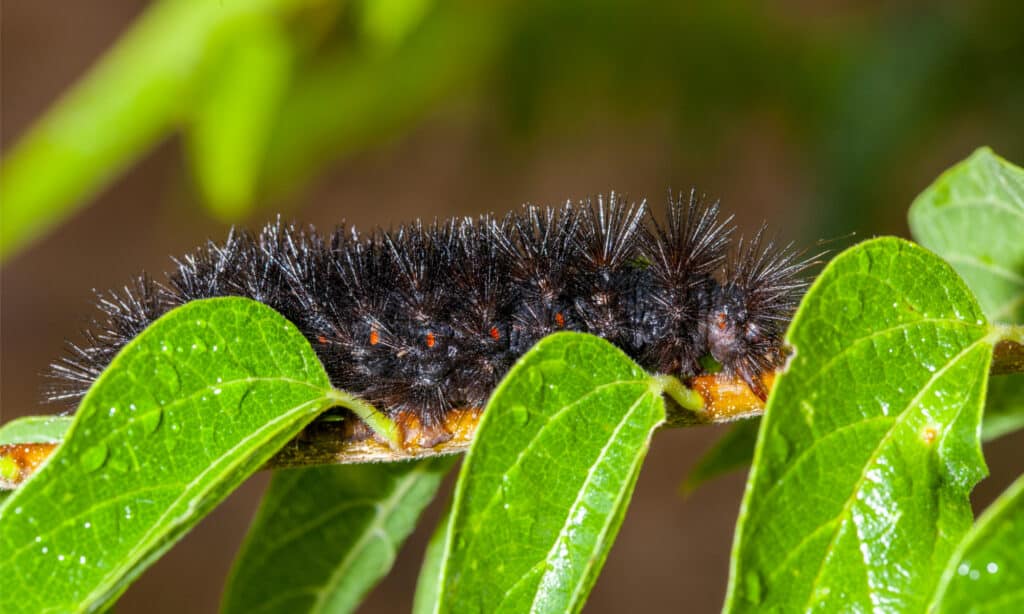
The giant
leopard
moth caterpillar is not technically poisonous.
©iStock.com/Eblis
As you might be able to guess from its name, the giant leopard moth caterpillar will eventually transform into a large, stunning moth! Its entire body is covered with black bristles interspersed with red rings. This type of caterpillar is frequently discovered in a coiled up position, which is how it shields itself.
The caterpillars of the giant leopard moth have a varied diet, munching on the fruits and leaves of a range of plants, including maples, sunflowers, cabbage, orange, violets, dandelion, cherries, and willows.
While these caterpillars are not technically poisonous, their bristles can cause some irritation.
When fully grown, giant leopard moths are enormous, measuring up to 3.5 inches across. Their bodies are strikingly white in color with a speckled pattern.
10. Banded Tussock Caterpillar (Halysidota tessellaris)
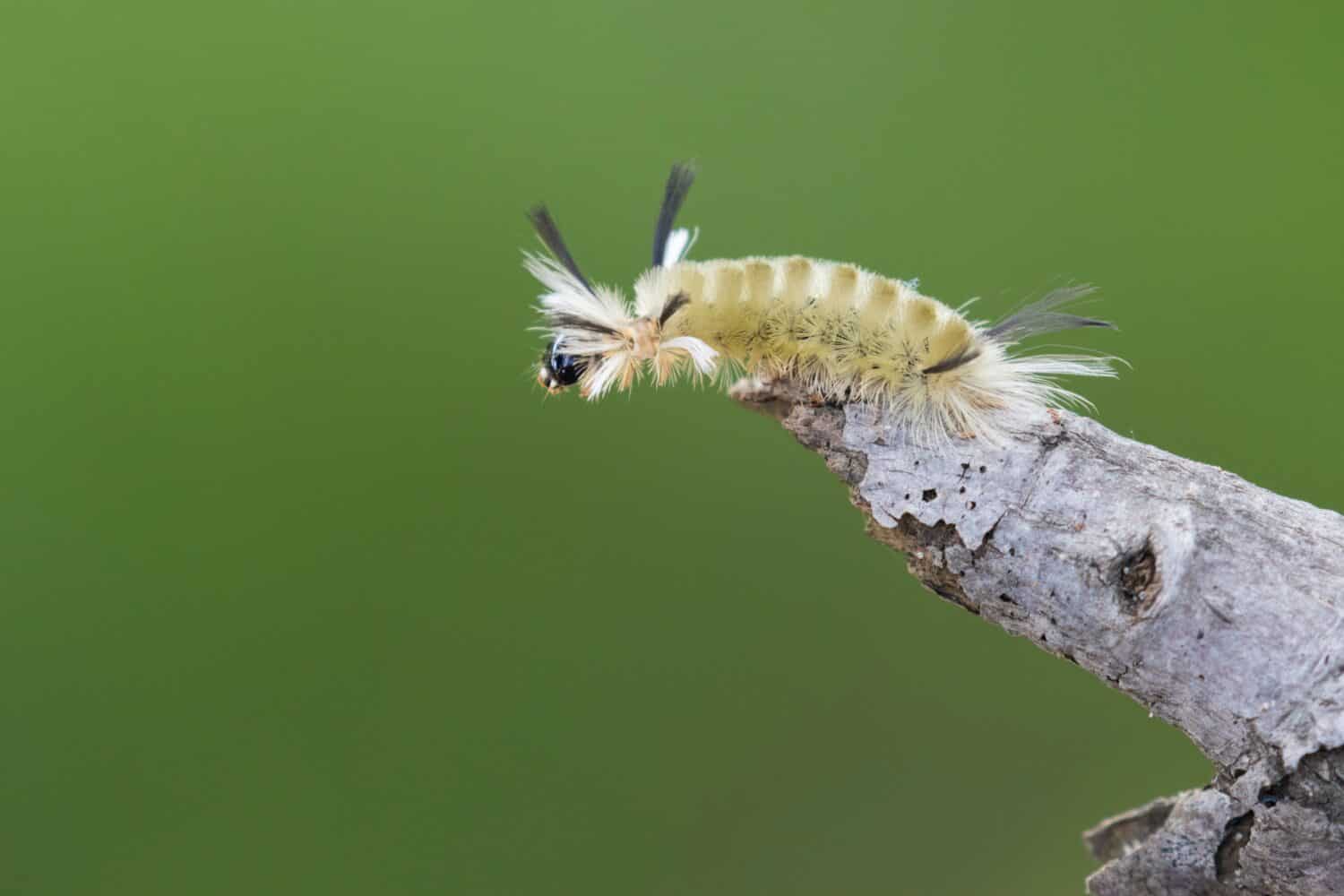
The banded tussock caterpillar is not a true tussock and is not venomous.
©Mircea Costina/Shutterstock.com
At first glance, the banded tussock caterpillar may seem identical to other tussock caterpillars, but there’s a twist – it’s not actually a true tussock caterpillar! It is instead a tiger moth.
Its body displays an array of light hues, ranging from cream and yellow to light brown or white. Black clumps of hair protrude from its head and rear, standing out against the lighter hairs. A single dark stripe goes across the center of its back. The banded tussock caterpillar usually opts for alder, ash, and fruit trees as its preferred dwelling plants.
Unlike the true tussock caterpillars, this species is non-venomous. However, some people might be overly sensitive to the hairs on their bodies, which can lead to a rash. Therefore, even if you’ve identified a banded tussock caterpillar, it’d be wiser to observe it from a distance rather than handle it directly!
11. Monarch Caterpillar (Danaus plexippus)
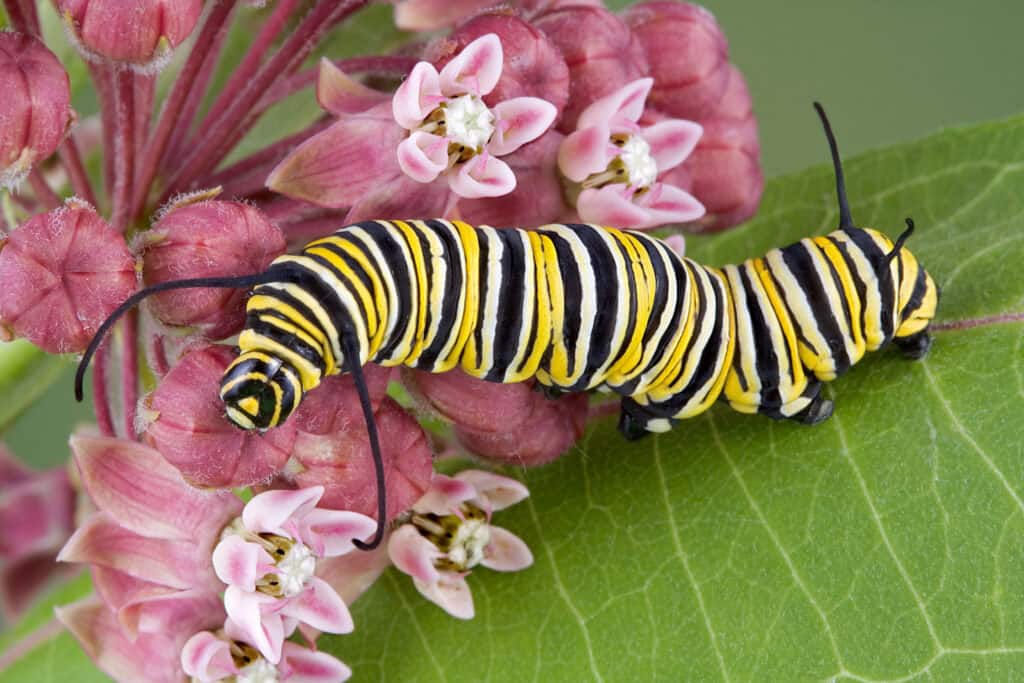
Monarch caterpillars love milkweed.
©Cathy Keifer/Shutterstock.com
Just like its butterfly form, the monarch caterpillar is among the most easily identified caterpillars in Florida!
This well-known caterpillar has a chubby body covered with yellow, black, and white stripes. Its legs, including the additional pro-legs, are prominent, and both ends of its body feature slender black antennae. Its favorite plant to call home is the milkweed.
Monarch caterpillars are not a tasty treat for most animals due to their toxic nature! This toxicity comes from their diet, which primarily consists of milkweed.
If milkweed plants are present in your yard or nearby, the chances of encountering monarch caterpillars are high!
12. Cabbageworm Caterpillar (Pieris rapae)
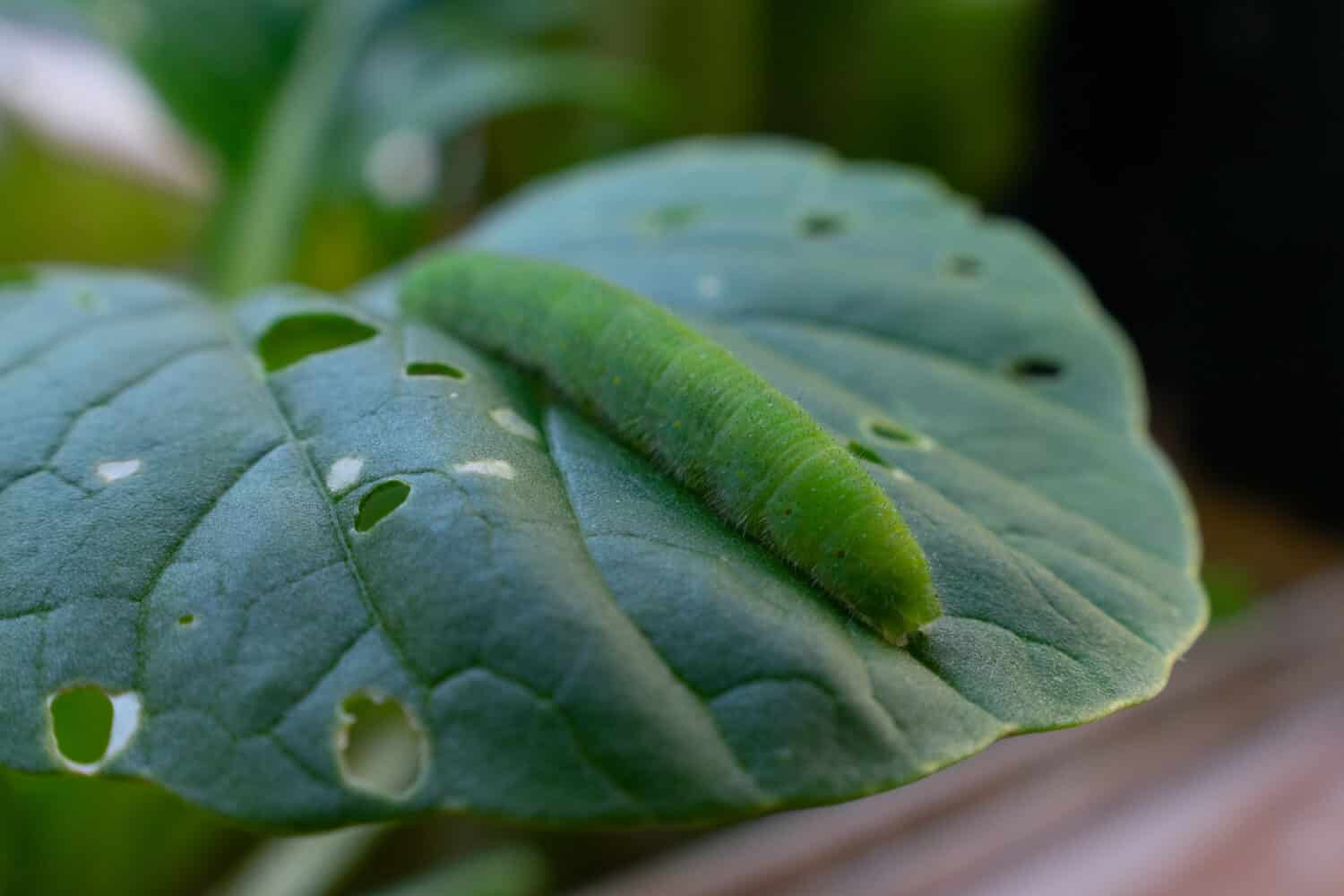
The cabbageworm caterpillar is a pest that causes a lot of damage to its host plants.
©Kelsey Armstrong Creative/Shutterstock.com
In Florida, this caterpillar is often referred to as the imported cabbageworm, given that it’s not native to North America. The species was unintentionally brought over with shipments of cabbage and other brassica plants, eventually establishing itself as an invasive species.
The body is a subtle shade of green. This caterpillar is relatively thin and small, with a velvety appearance. Its chosen host plants are kale, broccoli, cabbage, and chard.
Cabbageworms eventually mature into cabbage white butterflies. In fact, they are one of the most prevalent butterfly species in Florida!
Given their potential to cause significant damage to their host plants, cabbageworms are often deemed agricultural pests.
13. Woolly Bear Caterpillar (Pyrrharctia isabella)
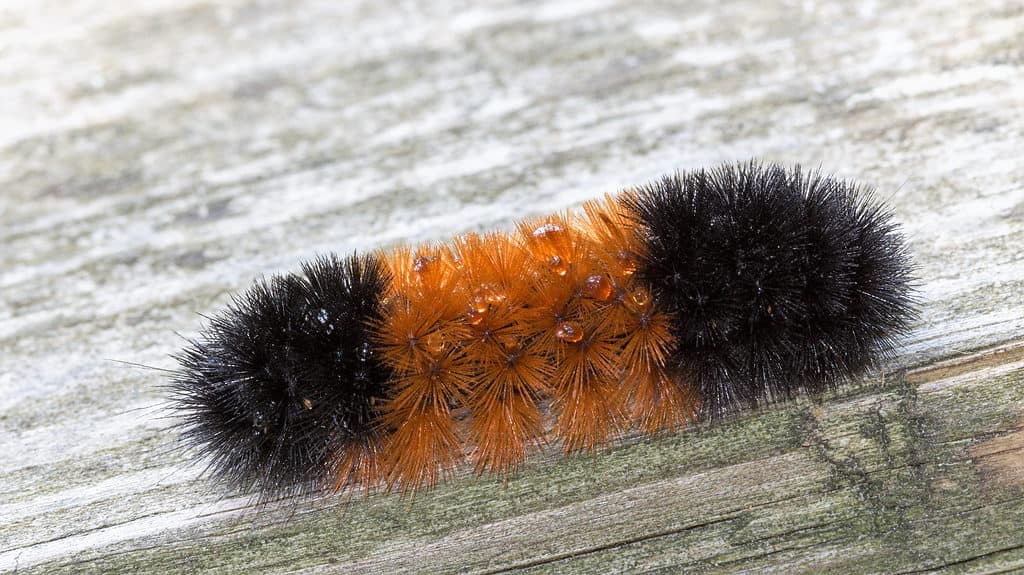
The woolly bear caterpillar is black and rusty-red in color.
©Kimberly Boyles/Shutterstock.com
The body of the woolly bear caterpillar features a stark black color with a broad, rusty-red band across the middle. As its name implies, the woolly bear caterpillar sports a thick coat of bristly hairs. This caterpillar will eventually become an isabella tiger moth.
These woolly bear caterpillars aren’t picky eaters, meaning they can survive on and devour almost any type of plant!
There’s a popular belief that woolly bear caterpillars are venomous, but this isn’t accurate. However, with that said, while their hairs don’t hold any toxic substances or irritants, some people may still be sensitive to these hairs and could develop a minor rash upon contact.
14. Viceroy Caterpillar (Limenitis archippus)
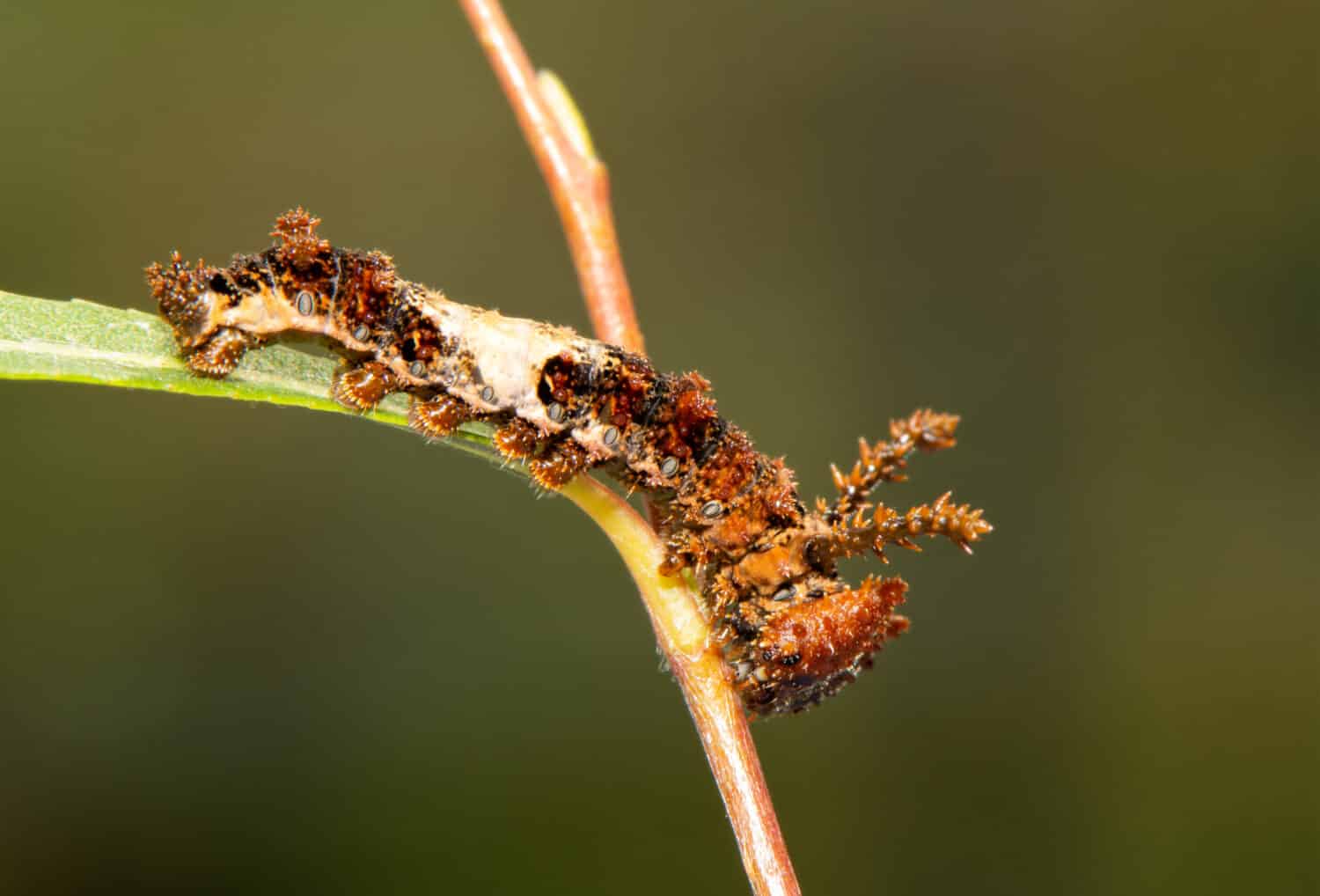
Monarch and viceroy butterflies look really similar, but in caterpillar form, the viceroy looks completely different!
©Sari ONeal/Shutterstock.com
Viceroy caterpillars may not win any beauty contests in Florida. Their body color is a patchy mix of white or brown and green. They have two dark horns on their heads and tiny spines covering their bodies. Their preferred dwelling plants are poplar, willow, and cottonwood trees. Viceroy caterpillars are primarily found in fields or open forests and can adapt to a wide range of climates.
Any predators tempted to make a meal out of them are met with an intense, bitter taste and a troubled tummy. After just one bite, they quickly learn to steer clear from the viceroy caterpillars!
Interestingly enough, while the viceroy and monarch butterflies look really similar, they look quite different during their caterpillar stages.
15. Zebra Longwing Caterpillar (Heliconius charithonia)
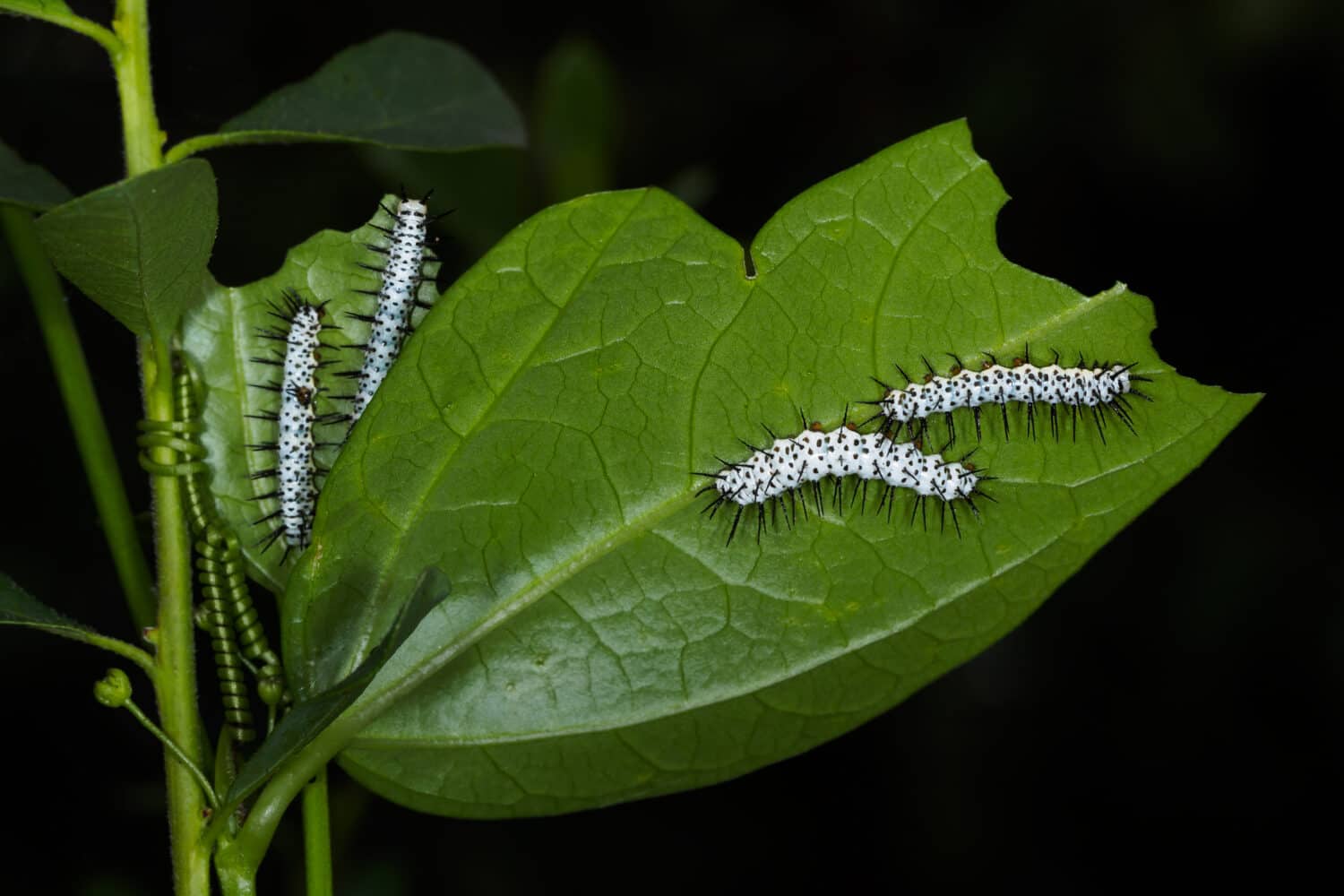
A toxic caterpillar, the zebra longwing is black and white in color.
©Francisco Herrera/Shutterstock.com
Zebra longwing caterpillars are unique in that their colors match those of the adult butterfly of the same species.
Just as the species name suggests, this caterpillar boasts a striking contrast of black and white colors. Mirroring the black and white zebra longwing butterfly, the caterpillar has a white body dotted with petite black spots. Small black prickles are distributed all over the caterpillar’s body.
Their coloration serves as a signal to predators, indicating their toxic nature. The source of this toxicity comes from chemicals known as cyanogenic glycosides, which have a bitter taste and can be harmful if consumed.
Zebra longwing caterpillars reside on and munch on passionflower.
Regions in Florida with the Most Caterpillars
Florida, an insect-rich state, is renowned for its abundant caterpillar population. Regions with dense foliage, such as the Everglades and the panhandle, host the highest number of caterpillars in the state. Tampa Bay and Miami also teem with these insects, especially in lush suburban gardens.
Central Florida is another hotbed, its climate favoring caterpillar development. A perfect environment for caterpillars would ideally contain a variety of native plants that caterpillars feed on. This provides a constant food supply. It should also offer some form of shelter and protection, like dense foliage or leaf litter, to hide from predators and harsh weather.
Finally, climatic conditions play a significant role. Caterpillars, like most insects, thrive in warmer conditions. They are cold-blooded, so their activity levels increase with warmer temperatures, enabling them to eat more and grow faster.
Summary of 15 Caterpillars Found in Florida
| Number | Caterpillar | Type of Caterpillar | Poisonous? |
|---|---|---|---|
| 1 | Flannel Moth Caterpillar | Moth | Yes |
| 2 | Io Moth | Moth | Yes |
| 3 | Spotted Apatelodes Caterpillar | Moth | No |
| 4 | Monkey Slug | Moth | Yes |
| 5 | Cecropia Moth Caterpillar | Moth | No |
| 6 | Spicebush Swallowtail Caterpillar | Butterfly | No |
| 7 | Eastern Tiger Swallowtail Caterpillar | Butterfly | No |
| 8 | Parsley Caterpillar | Butterfly | No |
| 9 | Giant Leopard Moth | Moth | No |
| 10 | Banded Tussock Caterpillar | Moth | No |
| 11 | Monarch Caterpillar | Butterfly | Yes |
| 12 | Cabbageworm Caterpillar | Butterfly | No |
| 13 | Woolly Bear Caterpillar | Moth | No |
| 14 | Viceroy Caterpillar | Butterfly | Yes |
| 15 | Zebra Longwing Caterpillar | Butterfly | Yes |
The photo featured at the top of this post is © K Hanley CHDPhoto/Shutterstock.com
Thank you for reading! Have some feedback for us? Contact the AZ Animals editorial team.



